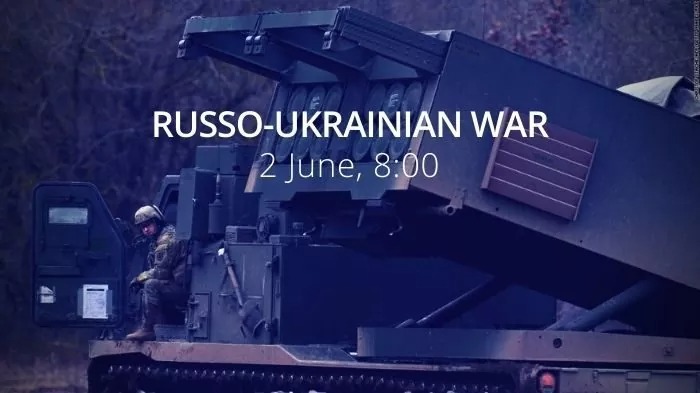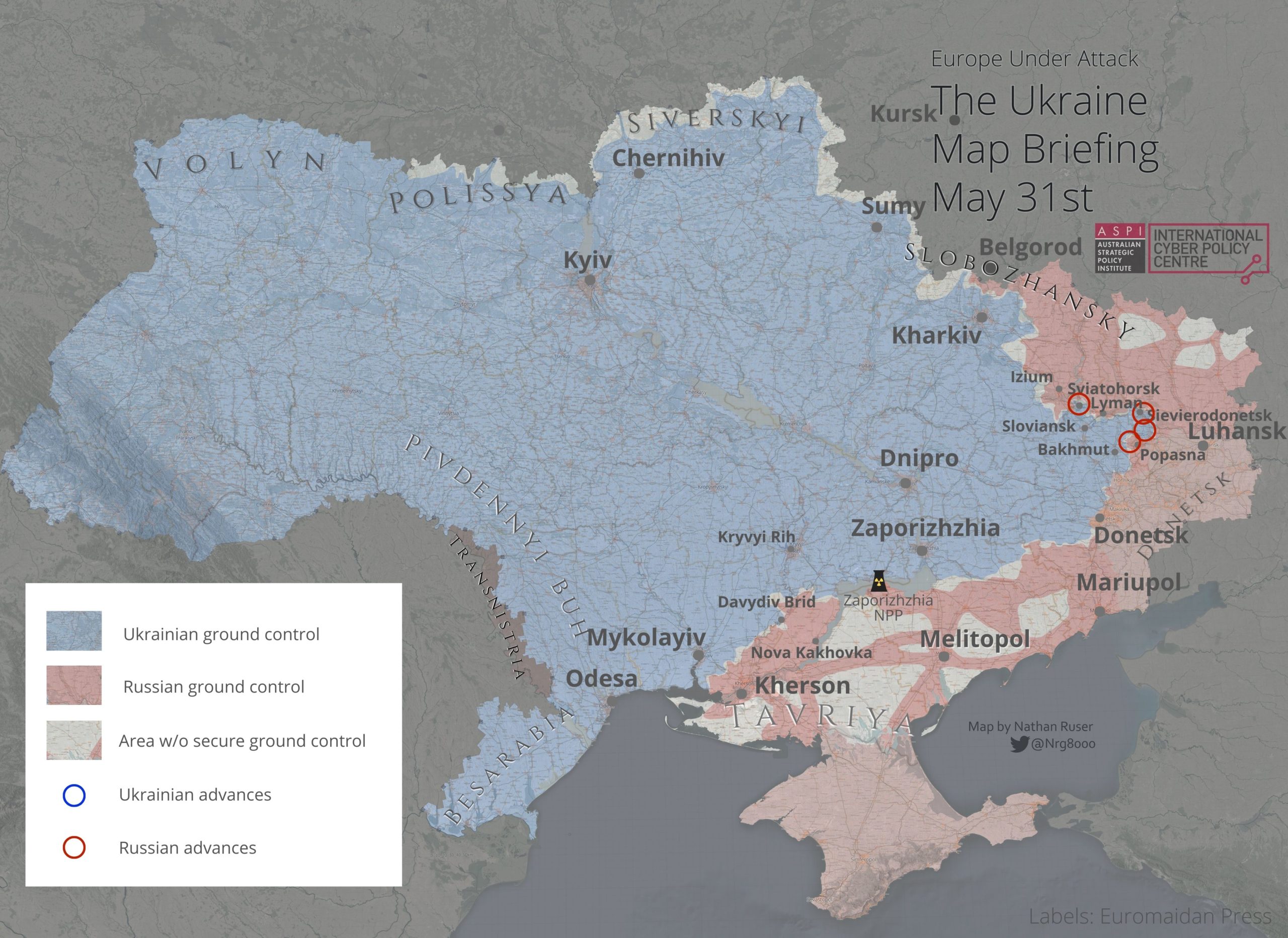 Heavy fighting continues on the fronts. An overview by military analyst Roman Ponomarenko:
Sloviansk direction: Lyman has been captured by Russia for a couple of days now; however, this has not led to a catastrophe for Ukrainian forces. Ukrainian units withdrew in an organized manner, crossed the Siverskyi Donetsk river, destroyed the bridges, and took up convenient defensive positions on the heights along its western shore. The Russians did not manage to break through immediately across the river. Now they will have to cross it under Ukrainian fire.
Fighting also begins directly for Sviatohirsk, to which Russia moves forces from several directions, most actively - from the northeast (from Yarova). North of Sloviansk, the Ukrainian Armed Forces have been holding Russian troops near the village of Dovhenke for a week now.
Luhansk Oblast: 80% of Sievierodonetsk is already under enemy control, likely because the Ukrainian Army was ordered to leave the city to avoid encirclement and is now fighting only restraining battles to retreat in an organized manner.
Heavy fighting continues on the fronts. An overview by military analyst Roman Ponomarenko:
Sloviansk direction: Lyman has been captured by Russia for a couple of days now; however, this has not led to a catastrophe for Ukrainian forces. Ukrainian units withdrew in an organized manner, crossed the Siverskyi Donetsk river, destroyed the bridges, and took up convenient defensive positions on the heights along its western shore. The Russians did not manage to break through immediately across the river. Now they will have to cross it under Ukrainian fire.
Fighting also begins directly for Sviatohirsk, to which Russia moves forces from several directions, most actively - from the northeast (from Yarova). North of Sloviansk, the Ukrainian Armed Forces have been holding Russian troops near the village of Dovhenke for a week now.
Luhansk Oblast: 80% of Sievierodonetsk is already under enemy control, likely because the Ukrainian Army was ordered to leave the city to avoid encirclement and is now fighting only restraining battles to retreat in an organized manner.
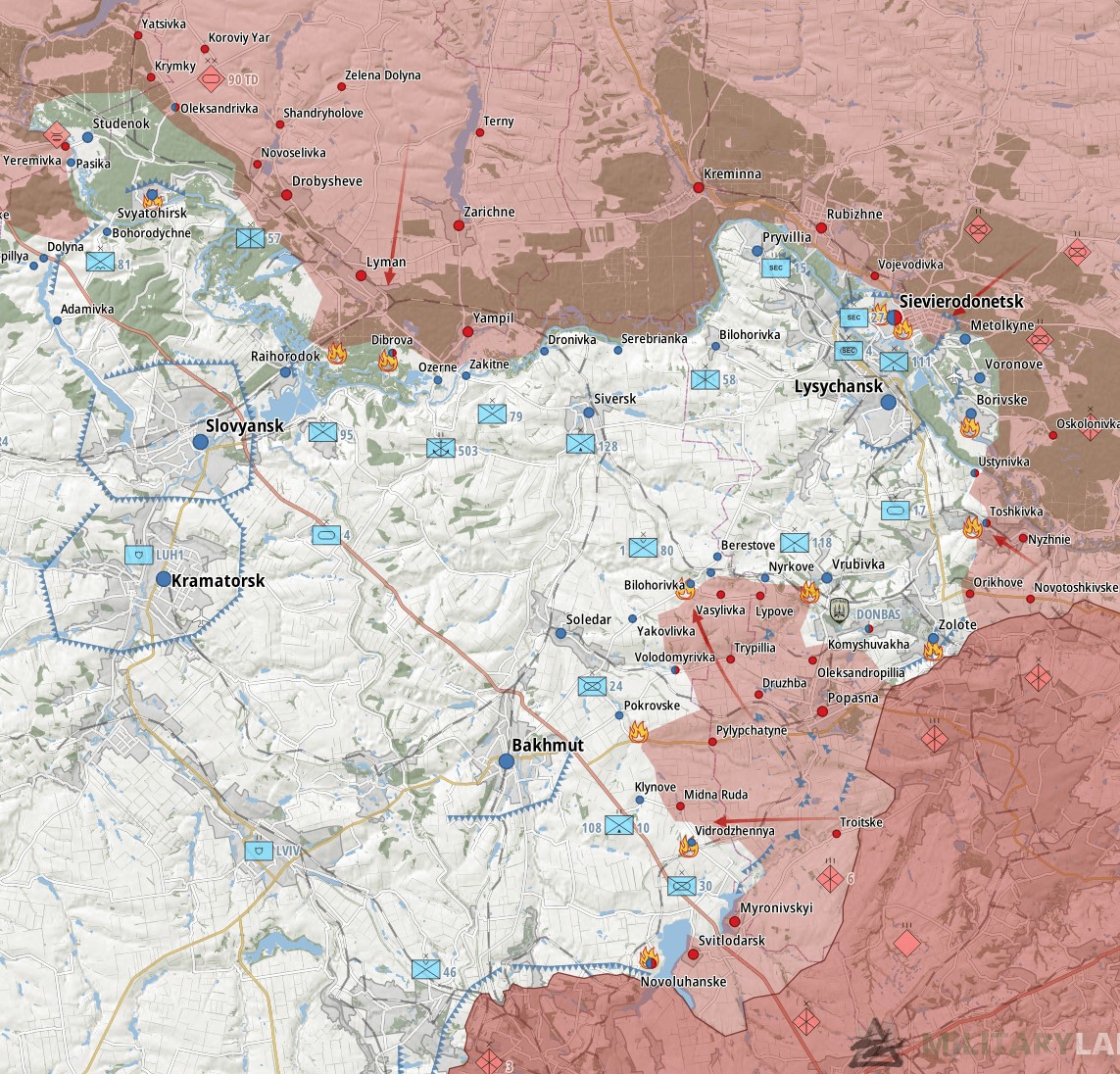
- [The main efforts of the Armed Forces of the Republic of Belarus are focused on conducting reconnaissance, engineering equipment for positions and conducting combat training activities. Mobilization exercises with military commissariats in the Gomel region are planned for June-July this year.]
- [No signs of the formation of strike groups were found. To demonstrate the presence and restraint of units of the Defense Forces, Russian forces continue to maintain units of the Armed Forces of the Russian Federation in the border areas of the Bryansk and Kursk regions.]
- From the territory of the Russian Federation, the enemy fired mortars at the settlements of Seredyna-Buda, Progress, Sumy Oblast, and Leonivka, Chernihiv Oblast.
- [Yesterday, Russian forces fired artillery at units of the Defense Forces in the areas of the settlements of Bilopillya and Stukalivka, Sumy oblast.]
- [In the Kharkiv direction, yesterday the Russian forces fired at the positions of the Defense Forces with artillery and MLRS in the areas of the settlements of Ruski Tyshky, Zolochiv and Derhachi.]
- In the Sloviansk direction, Russian forces focused on maintaining their positions, conducting reconnaissance and creating conditions for the resumption of the offensive. It carried out artillery shelling in the areas of Dovhenke, Kurulka, Virnopillya and Dolyna. [Yesterday, Russian forces fired artillery at our units in the areas of Svyatohirsk and Ridne. It conducted an offensive in the direction of Dovhenky and Dibrivny, suffered losses and withdrew.]
- In the Lyman direction, the enemy fought in the direction of the settlement of Raihorodok, suffered losses and withdrew.
- In the Sievierodonetsk direction, Russian forces are conducting assault operations in the settlement of Sievierodonetsk. [They have partial success, and have established control over the eastern part of Sievierodonetsk.]
- With the support of mortar fire, he stormed the settlements of Bobrove and Ustynivka, to no avail.
- In the Bakhmut direction, Russian forces are storming the village of Komyshuvakha to take control of the city, which has partial success, but the fighting continues. He stormed the settlements of Nahirne and Bilohorivka, and as a result of the fire inflicted by our units, he withdrew.
- In the Avdiivka, Kurakhivka, Novopavlivsk and Zaporizhzhia directions, Russian forces did not conduct active hostilities. It fired at Ukrainian troops with artillery and mortars in the areas of the settlements of Pisky, Avdiivka, Uspenivka, Vuhledar, Novosilka and Orikhiv.
- In the Novopavlivsk and Zaporizhzhia directions, Russian forces continue the engineering equipment of the occupied frontiers. Carries out replenishment of stocks.
- Over the past 24hrs, thirteen enemy attacks have been repulsed in the Donetsk and Luhansk directions, two tanks, six artillery systems, eight armoured combat vehicles and four enemy vehicles have been destroyed. Air defence units shot down seven Orlan-10 UAVs.
- [Yesterday, Russian forces increased the intensity of fire damage to our troops with mortars and artillery in the areas of the settlements of Snihurivka, Vysokopillya and Zolota Balka. Continued shelling of objects of civil infrastructure and residential quarters, shelled the city of Mykolayiv.]
- To justify the destruction of civilian objects, Russian occupiers continue to spread information about the alleged location of military units in schools, hospitals and kindergartens.
- In the Bessarabian direction, no significant changes in the activities of Russian forces units were noted.

- Russia has taken control of most of Sievierodonetsk. The main road into the Sievierodonetsk pocket likely remains under Ukrainian control but Russia continues to make steady local gains, enabled by a heavy concentration of artillery. This has not been without cost, and Russian forces have sustained losses in the process.
- Crossing the Siverskyi Donets River - which is a natural barrier to its axes of advance – is vital for Russian forces as they secure Luhansk Oblast and prepare to switch focus to Donetsk Oblast. Potential crossing sites include between Sievierodonetsk and the neighbouring town of Lysychansk; and near recently-captured Lyman. In both locations, the river line likely still remains controlled by Ukrainian forces, who have destroyed existing bridges.
- It is likely Russia will need at least a short tactical pause to re-set for opposed river crossings and subsequent attacks further into Donetsk Oblast, where Ukrainian armed forces have prepared defensive positions. To do so risks losing some of the momentum they have built over the last week.
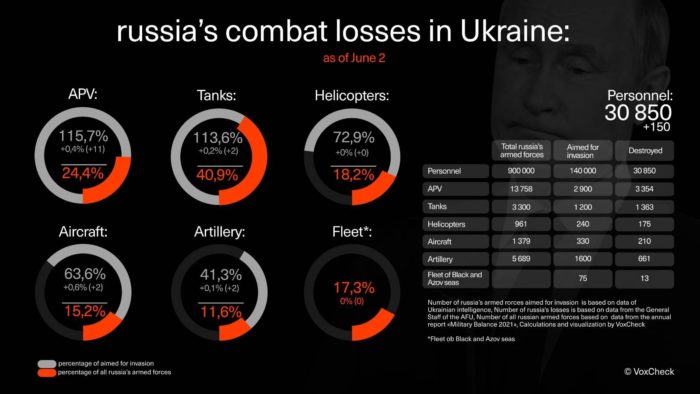
- Personnel – more than 30850 (+150),
- Tanks – 1363 (+2),
- Armoured combat vehicles – 3354 (+11),
- Artillery systems – 661 (+2),
- Multiple rocket launchers –MLRS - 207 (+0),
- Air defence means – 95 (+1),
- Aircraft - 210 (+2),
- Helicopters - 175 (+0),
- Automotive technology and fuel tanks – 2325 (+35),
- Vessels/boats - 13 (+0),
- UAV operational and tactical level – 521 (+2),
- Special equipment – 51 (+2),
- Mobile SRBM system – 4 (+0),
- Cruise missiles – 120 (+0)
Humanitarian
Police report the number of children who have gone missing during the war, Ukrainska Pravda reports. “139 Ukrainian children are currently missing, Ihor Klymenko, the Head of the National Police of Ukraine, reports. More than 1.9 thousand children have been reported missing during the war. Of these, the police have found and returned 1,794 children to their relatives. Almost 100 days of the war in Ukraine have led to devastating consequences for children on a scale and at a pace not seen since World War II", – was declared on children's day at UNICEF. According to the UN High Commissioner for Human Rights, 2 children are killed every day in Ukraine, and 4 are injured mainly as a result of attacks involving the use of explosive weapons in settlements.” There is a huge shortage of medicines in the occupied territories as Russian Federation blocks delivery attempts – Liashko, Ukrainska Pravda reports. “There is a huge shortage of medicines in the temporarily occupied territories of Ukraine. Even saline is scant, [Viktor Liashko, Minister of Health, said]. According to Liashko, thus far no humanitarian corridor has been organised to allow the Ukrainian side to deliver medicine to health care facilities under occupation. The Ministry of Health of Ukraine is currently communicating with the International Committee of the Red Cross and the World Health Organisation to force Russia to take action under the Convention for the Protection of Civilian Persons in Time of War.” According to UNHCR 6,801,987 refugees have been registered as of May 29. The UN says that so far Poland has taken in 3,627,178 refugees, Romania 989,357, Russian Federation 971,417, Hungary 682,594, Republic of Moldova 479,513, Slovakia 461,164 and Belarus 30,092. Among those who fled Ukraine are also Ukrainian nationals with dual citizenship. An additional 105,000 people moved to the Russian Federation from the Donetsk and Luhansk regions between 18 and 23 February. The number of Ukrainians entering Ukraine since February 28 is 2,229,500 as of May 27. This figure reflects cross-border movements, which can be pendular, and does not necessarily indicate sustainable returns. OHCHR recorded 9,094 civilian casualties in Ukraine as of May 31. 4,149 were killed (including 267 children) and 4,945 injured (including 423 children). Russian occupiers imprison and execute Ukrainian volunteers and officials refusing to collaborate, Mariupol mayor Vadym Boychenko says. According to him, a sham "court" of the "Donetsk People's Republic" sentenced the head of a settlement on the Azov coast to 10 years in prison. At least one public official was executed by a firing squad. Also, tens of Ukrainian volunteers who had helped evacuate from Mariupol and tried to deliver food and water into the besieged city are being held in a prison in Olenivka. A Ukrainian judge awaits the verdict of the Russian puppet "republic," there are reports she was tortured. https://twitter.com/EuromaidanPress/status/1532376808037011456Environmental
What you need to know about Russia's blockade of Odesa, the ABC News reports. ODESA, Ukraine -- Russia's invasion of Ukraine has meant vital food exports are stuck in Ukraine's ports. […]Legal
Ukraine identifies 600 Russian war crime suspects, Aljazeera reports. “Ukraine has identified more than 600 Russian war crime suspects and has started prosecuting about 80 of them, Kyiv’s top prosecutor said. The list of suspects includes “top military, politicians and propaganda agents of Russia”, Prosecutor General Iryna Venediktova told a news conference in The Hague on Tuesday as she met her counterparts from other countries.” 261 children were killed, and 460 children injured, the Office of the Prosecutor General of Ukraine reports as of June 2. 1,938 educational establishments are damaged as a result of shelling and bombings, 182 of them are destroyed fully. 15,228 crimes of aggression and war crimes and 7,154 crimes against national security were registered.Support
$700 Million in Additional Security Assistance for Ukraine (US Department of Defense Press release). Today, June 1, the Department of Defense (DoD) announced the authorization of a Presidential Drawdown of security assistance valued at up to $700 million, tailored to meet critical Ukrainian needs for today’s fight. This authorization is the eleventh drawdown of equipment from DoD inventories for Ukraine since August 2021. Capabilities in this package include High Mobility Artillery Rocket Systems and ammunition; Five counter-artillery radars; Two air surveillance radars; 1,000 Javelins and 50 Command Launch Units; 6,000 anti-armour weapons; 15,000 155mm artillery rounds; Four Mi-17 helicopters; 15 tactical vehicles; and Spare parts and equipment. The United States has now committed approximately $5.3 billion in security assistance to Ukraine since the beginning of the Biden Administration, including approximately $4.6 billion since the beginning of Russia’s unprovoked invasion on February 24. UK to give Ukraine 80km-range MLR systems, Ukrinform reports citing CNN. “Britain will send M270 launchers able to strike targets up to 80 kilometres (49.7 miles) away, offering “a significant boost in capability for the Ukrainian forces,” according to a statement from the British Foreign Office. The move has been “coordinated closely” with the United States decision to provide Ukraine with its High Mobility Artillery Rocket System (HIMARS) – a variant of the multiple-launch rocket systems that will be gifted by the UK, the statement added”. https://twitter.com/EuromaidanPress/status/1532268277925175296 The US plans to sell armed drones to Ukraine in the coming days, Reuters claims.“The Biden administration plans to sell Ukraine four MQ-1C Gray Eagle drones that can be armed with Hellfire missiles for battlefield use against Russia, three people familiar with the situation said. The sale of the General Atomics-made drones could still be blocked by Congress, the sources said, adding that there is also a risk of a last-minute policy reversal that could scuttle the plan, which has been under review at the Pentagon for several weeks. Ukraine has been using several types of smaller shorter range unmanned aerial systems against Russian forces that invaded the country in late February. They include the AeroVironment (AVAV.O) RQ-20 Puma AE, and the Turkish Bayraktar-TB2. But the Gray Eagle represents a leap in technology because it can fly up to 30 or more hours depending on its mission and can gather huge amounts of data for intelligence purposes. Gray Eagles, the Army's version of the more widely known Predator drone, can also carry up to eight powerful Hellfire missiles. The sale is significant because it puts an advanced reusable US system capable of multiple deep strikes on the battlefield against Russia for the first time.”
Germany promises to send Ukraine a missile defense system and radar equipment, The New York Times reports.Areas that the MQ-1C Gray Eagle Drone can reach when launched from major Ukrainian Airports, courtesy of @ukraine_map
— Euromaidan Press (@EuromaidanPress) June 2, 2022
With a range of 400km & speed up to 280km/h, the drone mainly does reconnaissance but can also be used as a strike drone. The US plans to sell Ukraine 4 of them pic.twitter.com/P8XXJNP9J4
“Chancellor Olaf Scholz of Germany on Wednesday promised two more potentially significant donations of heavy weapons to Ukraine — an air-defence system [IRIS-T] and a tracking radar to help the Ukrainian army locate sources of Russian heavy artillery […]. The air-defence system, he said, is among the most sophisticated in the German arsenal and could be deployed to protect whole cities. The speed and scale of weapons donations to Ukraine have been a persistent source of criticism for Mr. Scholz both from Ukraine and from inside Germany, even as he has spoken of breaking with decades of pacifist policy. But Mr. Scholz did not immediately specify delivery timelines for the latest weapons.”Three More Nations Join Ukraine Planning Cell Run By US Army Special Forces, Defense One reports. Three more countries have joined a coordination effort set up by US Army special forces to help Ukraine, the Army secretary said Tuesday. When Russia went into Ukraine in late February, we sent the 10th Special Forces Group to develop a coalition planning cell that enabled us to bring together 20 different nations to coordinate information with international [special operations forces] partners and allies, Army Secretary Christine Wormuth said during a virtual event with the Atlantic Council. And that has again, I think, contributed significantly to the effectiveness and the speed of the assistance and training that we've been able to provide. The planning cell had 17 members in April, when Lt. Gen. Jonathan Braga, the commander of US Army Special Operations Command, testified to senators.” Ukraine and Poland plan to set up a joint defence enterprise to produce weapons and equipment, Ukrinform reports. "A memorandum on the establishment of a joint Polish-Ukrainian commission to launch cooperation between the enterprises of our countries was signed. This commission will prepare recommendations on the format of establishing a Ukrainian-Polish joint enterprise to produce weapons and military equipment," Prime Minister of Ukraine Denys Shmyhal said at a joint briefing with Prime Minister of Poland Mateusz Morawiecki in Kyiv. He noted that such an enterprise would take Ukraine-Poland defence cooperation to a new level and will allow for the production of modern types of defensive weapons”.
New developments
- West's "irrational fear" of Russia driving ceasefire push- Ukrainian negotiator, Reuters reports. “A Ukrainian presidential advisor and peace talks negotiator accused Europe and the United States of having an "irrational fear" of Russia in an interview released on Wednesday by news agency Interfax Ukraine. Mykhailo Podoliak, a key negotiator for Ukraine during previous talks with Russia, said the political elites of the West "want to return to the pre-war period and do not want to solve problems," adding that their financial priorities took precedence in decision-making”.
- Kremlin claims Kyiv delaying peace talks due to US arms supplies, Ukrainska Pravda reports. Dmitriy Peskov, press secretary to the President of the Russian Federation, claims that the US arms supply agreements are not conducive to Kyiv’s "willingness to resume peace talks." [Which translates into: The US arms supply enables Ukraine to defend itself instead of giving in to Russian ultimatums.]
- Russia's Lavrov warns US rocket supplies could widen Ukraine conflict, Reuters reports. “Russian Foreign Minister Sergei Lavrov said the supply of US advanced rocket launchers to Ukraine raised the risks of a "third country" being dragged into the conflict. Lavrov was responding to a question at a news conference in Saudi Arabia about US plans to provide Ukraine with advanced rocket systems that can strike with precision at long-range Russian targets.”
- Ukraine has assured the US it will not use weapons systems against targets in Russia – Blinken, Reuters reports. “US Secretary of State Antony Blinken said on Wednesday that Ukraine had given assurances that it will not use long-range weapons systems provided by Washington against targets on Russian territory.” [ME: Due to the sensitivity of the issue, there is a risk Russia will create a False Flag operation to exploit the situation to its benefit.]
- Russia announces exercises with Yars intercontinental ballistic missiles, Ukrainska Pravda reports. According to Interfax, the Ministry of Defence of the Russian Federation has announced that “Russian Strategic Missile Forces are taking part in exercises involving autonomous launchers of Yars [an abbreviation, in Russian, of ‘nuclear deterrence rocket’, a Russian thermonuclear-armed intercontinental ballistic missile - ed.] strategic missile systems.”
- Gazprom cuts gas supply to Orsted and Shell Energy, Reuters reports. “Russian gas producer Gazprom has cut off gas supplies to Denmark's Orsted and Shell Energy for its contract to supply gas to Germany, it said on Wednesday, citing the companies' failure to make payments in roubles. Gazprom has already halted supplies to Dutch gas trader GasTerra, as well as to Bulgaria, Poland and Finland after they refused to pay for gas in Russian roubles, as demanded by Moscow in response to Western sanctions over the Russia-Ukraine conflict. German, Italian and French companies, however, have said they would engage with Moscow's payment scheme to ensure they can maintain supplies.”
- Denmark to join EU defence policy after a historic vote, Reuters reports. “Denmark will join the European Union's defence policy after a referendum on Wednesday, final results showed, signalling the latest shift among Nordic countries to deepen defence ties in response to Russia's invasion of Ukraine”.
Assessment
1. On the War
The Institute for the Study of War has made the following assessment as of Wednesday 1 June: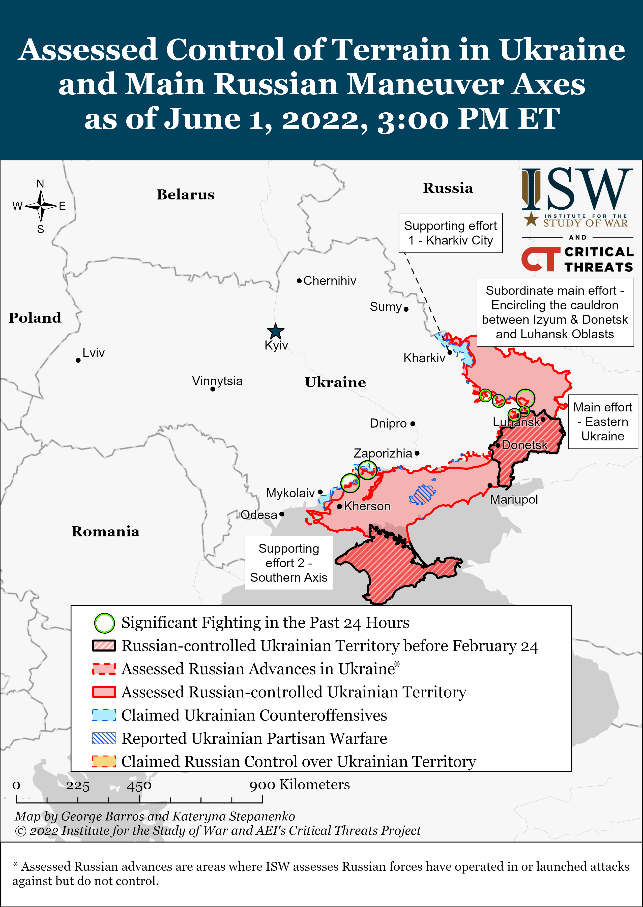 Russian authorities are likely anticipating Ukrainian partisan pressure in Luhansk Oblast. The Main Ukrainian Intelligence Directorate (GUR) announced on June 1 the launch of the “Luhansk partisan” project to galvanize resistance to Russian attempts to consolidate control of Luhansk Oblast. A Russian Telegram channel reported that the Russian Internal Ministry is sending a special detachment of its employees on “leave” to the Luhansk People's Republic (LNR), which is a likely attempt to reinforce Russian administrative presence in the LNR in the face of growing internal and partisan discontent. The Ukrainian General Staff additionally stated that Russian forces moved a battalion tactical group (BTG) to Kupiansk, a Russian-controlled city in eastern Kharkiv Oblast along the P07 highway within 30 kilometers of the Luhansk Oblast administrative border. Kupiansk is far from the front lines and in no apparent danger of imminent Ukrainian conventional attack. Taken together, the reported deployment of Internal Ministry employees and a BTG suggest that Russian forces are anticipating partisan resistance against their attempts to gain control of Luhansk Oblast.
Russian forces continue to undermine the economic viability of areas they are attempting to capture. Russian forces reportedly hit the “Azot” fertilizer production plant in Sievierodonetsk on May 31 and caused the dissemination of toxic nitric acid smoke. The production plant was an economically-significant resource for Sievierodonetsk and the Luhansk region and it would have been prudent for Russian forces to maintain and take control of the plant’s production capabilities. Russian forces similarly destroyed the Azovstal Steel Plant in Mariupol, which had considerable industrial significance for Ukraine and could have been economically exploited by Russian occupiers if they had not destroyed it. While the Azot plant in Sievierodonetsk was less productive on whole than Azovstal, its destruction is part of the systemic failure of Russian forces to take effective control of the economic and industrial capabilities of occupied territory. Russian forces will likely continue to destroy productive infrastructure and continually undermine the economic benefits they could have hoped to gain from occupied territories.
Key Takeaways
Russian authorities are likely anticipating Ukrainian partisan pressure in Luhansk Oblast. The Main Ukrainian Intelligence Directorate (GUR) announced on June 1 the launch of the “Luhansk partisan” project to galvanize resistance to Russian attempts to consolidate control of Luhansk Oblast. A Russian Telegram channel reported that the Russian Internal Ministry is sending a special detachment of its employees on “leave” to the Luhansk People's Republic (LNR), which is a likely attempt to reinforce Russian administrative presence in the LNR in the face of growing internal and partisan discontent. The Ukrainian General Staff additionally stated that Russian forces moved a battalion tactical group (BTG) to Kupiansk, a Russian-controlled city in eastern Kharkiv Oblast along the P07 highway within 30 kilometers of the Luhansk Oblast administrative border. Kupiansk is far from the front lines and in no apparent danger of imminent Ukrainian conventional attack. Taken together, the reported deployment of Internal Ministry employees and a BTG suggest that Russian forces are anticipating partisan resistance against their attempts to gain control of Luhansk Oblast.
Russian forces continue to undermine the economic viability of areas they are attempting to capture. Russian forces reportedly hit the “Azot” fertilizer production plant in Sievierodonetsk on May 31 and caused the dissemination of toxic nitric acid smoke. The production plant was an economically-significant resource for Sievierodonetsk and the Luhansk region and it would have been prudent for Russian forces to maintain and take control of the plant’s production capabilities. Russian forces similarly destroyed the Azovstal Steel Plant in Mariupol, which had considerable industrial significance for Ukraine and could have been economically exploited by Russian occupiers if they had not destroyed it. While the Azot plant in Sievierodonetsk was less productive on whole than Azovstal, its destruction is part of the systemic failure of Russian forces to take effective control of the economic and industrial capabilities of occupied territory. Russian forces will likely continue to destroy productive infrastructure and continually undermine the economic benefits they could have hoped to gain from occupied territories.
Key Takeaways
- Russian forces reportedly made incremental advances north of Sloviansk but likely have not yet been able to take control of the road into Sloviansk.
- Russian forces are attempting to advance towards Lysychansk from the south and west in order to avoid having to fight across the Siverskyi Donets River from Sievierodonetsk but are having limited successes so far.
- Russian troops made incremental gains north of Avdiivka.
- Russian troops reportedly destroyed Ukrainian-built bridges over the Inhulets River near Davydiv Brid in response to Ukrainian counteroffensive pressure.“
While brutally seizing Ukrainian territory and intending to annex it, the Russian authorities claim that they will take into account the opinion of the local residents. "We have repeatedly said that people should choose their own future, and it is the residents of the two states -" LNR" [self-proclaimed Luhansk People’s Republic] and "DNR" [self-proclaimed Donetsk People’s Republic] - and residents of the territories, I mean Kherson, Zaporizhzhia, who must decide about their future. And we have no doubt that they will make the best decision, [Dmitriy Peskov, spokesman to the president of the Russian Federation, commented on the possibility of occupied territories of Ukraine "joining Russia"]. Russia has annexed Crimea and controlled parts of Donetsk and Luhansk oblasts since 2014. Neither Ukraine nor Western countries have recognized this annexation and occupation, despite the occupying power’s pretence of holding "referendums".

